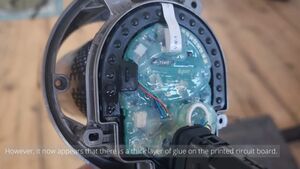Dyson: Difference between revisions
No edit summary |
clean-up |
||
| (25 intermediate revisions by 13 users not shown) | |||
| Line 1: | Line 1: | ||
{{StubNotice}} | {{StubNotice}} | ||
{{ | {{InfoboxCompany | ||
Dyson is a manufacturer of vacuum cleaners. | | Name = Dyson | ||
| Type = Private | |||
| Founded = 1991 | |||
| Industry = Household Appliances | |||
| Official Website = https://dyson.com/ | |||
| Logo = Dyson-Logo.webp | |||
}} | |||
'''{{Wplink|Dyson (company)|Dyson Limited}}''' is a manufacturer of home appliances, most notably vacuum cleaners. The company has been involved in several incidents related to the aftermarket repair of its products. | |||
== | ==Consumer impact summary== | ||
Dyson's policies have been troublesome for [[Planned obsolescence|product longevity]] and [[Right to repair|repair]]. | |||
* Their battery design speeds up degradation. | |||
* Adhesive on printed circuit boards makes easy repairs impossible, leading to expensive replacements. | |||
* Restricting consumers from using third-party repair shops, forcing them into manufacturer-recommended services. | |||
Dyson | These policies add costs of ownership and shorten product lifespan, harming consumers.[[File:Dyson-glued-button.jpg|thumb|Glued PCB, preventing repair.<ref name=":0">{{Cite web |author=@vacuumtester |title=Dyson Button Replacement is no Longer Possible |url=https://www.youtube.com/watch?v=KF0nNOAFnRQ |website=[[YouTube]] |date=16 Nov 2022 |access-date=17 Jul 2025 |url-status=live}}</ref>]] | ||
==Incidents<!-- Will split this into incidents and practices later on -->== | |||
===Battery lifespan reduction=== | |||
{{Main|Dyson intentionally reduces battery lifespan and makes them difficult to repair}} | |||
'''Dyson''' battery packs include a '''Battery Management System (BMS)''' equipped with a chip capable of balancing the individual cells. However, the manufacturer omitted a few inexpensive but essential resistors, preventing the balancing function from working as intended. As a result, the battery pack degrades much faster than it should. | |||
===Circuit boards covered in glue=== | |||
{{Main|Dyson covers circuit board in glue which prevents repairs}} | |||
'''[[Dyson]]''' started applying a thick layer of glue to the circuit board of their devices. This makes it impossible to replace the power button for a device when it breaks, and leading to consumers having to replace the entire housing. | |||
===Removing third-party repairs options=== | |||
{{Main|Dyson ends relationship with third-party repair centers}} | |||
The company no longer allows repairs through third-party repair centers. Dyson described this decision as ''"difficult"'' but emphasized its commitment to ensuring that ''"all services and repairs meet Dyson's high-quality standards for our owners"''. | |||
===Difficult to repair battery packs for Dyson V6 cordless vacuum=== | |||
The Dyson V6 uses replaceable battery packs that are available for purchase on their website.<ref>{{Cite web |title=Replacement Dyson V6™ vacuum battery |url=https://www.dyson.com/support/journey/tools/967810-23 |website=Dyson |date= |access-date=17 Jul 2025 |url-status=live |archive-url=https://web.archive.org/web/20250708183421/https://www.dyson.com/support/journey/tools/967810-23 |archive-date=8 Jul 2025}}</ref> The battery packs have a plastic casing that is clipped shut in such a way that opening it is impossible without damaging the casing. Additionally, the BMS used does not have a reset button. This leads to unnecessary replacements for the entire battery pack when a fault could have been resolved with a reset. For example, Steve Porter from TronicsFix was unable to repair a Dyson V6 battery pack that was stuck sending the voltage without the button pressed down because of the lack of a BMS reset button, and had to replace the whole battery.<ref>{{Cite web |author=@TronicsFix |title=Are Expensive Dyson Products Repairable? |url=https://youtu.be/Wa1dsoZK4tk?t=1109 |website=[[YouTube]] |date=28 Mar 2025 |access-date=17 Jul 2025 |url-status=live}}</ref> | |||
== | ===Using under-dimensioned trigger in V10/V11 cordless vacuum=== | ||
{{Main|Dyson V10/V11 trigger design}} | |||
The trigger design of the V10/V11 cordless vacuums uses under-dimensioned material that tend to break after some years of use. | |||
== References == | ==References== | ||
{{Reflist}} | |||
[[Category:Dyson]] | |||
Latest revision as of 00:23, 18 July 2025
❗Article Status Notice: This Article is a stub
This article is underdeveloped, and needs additional work to meet the wiki's Content Guidelines and be in line with our Mission Statement for comprehensive coverage of consumer protection issues. Learn more ▼
| Basic information | |
|---|---|
| Founded | 1991 |
| Legal structure | Private |
| Industry | Household Appliances |
| Official website | https://dyson.com/ |
Dyson Limited is a manufacturer of home appliances, most notably vacuum cleaners. The company has been involved in several incidents related to the aftermarket repair of its products.
Consumer impact summary[edit | edit source]
Dyson's policies have been troublesome for product longevity and repair.
- Their battery design speeds up degradation.
- Adhesive on printed circuit boards makes easy repairs impossible, leading to expensive replacements.
- Restricting consumers from using third-party repair shops, forcing them into manufacturer-recommended services.
These policies add costs of ownership and shorten product lifespan, harming consumers.

Incidents[edit | edit source]
Battery lifespan reduction[edit | edit source]
Dyson battery packs include a Battery Management System (BMS) equipped with a chip capable of balancing the individual cells. However, the manufacturer omitted a few inexpensive but essential resistors, preventing the balancing function from working as intended. As a result, the battery pack degrades much faster than it should.
Circuit boards covered in glue[edit | edit source]
Dyson started applying a thick layer of glue to the circuit board of their devices. This makes it impossible to replace the power button for a device when it breaks, and leading to consumers having to replace the entire housing.
Removing third-party repairs options[edit | edit source]
- Main article: Dyson ends relationship with third-party repair centers
The company no longer allows repairs through third-party repair centers. Dyson described this decision as "difficult" but emphasized its commitment to ensuring that "all services and repairs meet Dyson's high-quality standards for our owners".
Difficult to repair battery packs for Dyson V6 cordless vacuum[edit | edit source]
The Dyson V6 uses replaceable battery packs that are available for purchase on their website.[2] The battery packs have a plastic casing that is clipped shut in such a way that opening it is impossible without damaging the casing. Additionally, the BMS used does not have a reset button. This leads to unnecessary replacements for the entire battery pack when a fault could have been resolved with a reset. For example, Steve Porter from TronicsFix was unable to repair a Dyson V6 battery pack that was stuck sending the voltage without the button pressed down because of the lack of a BMS reset button, and had to replace the whole battery.[3]
Using under-dimensioned trigger in V10/V11 cordless vacuum[edit | edit source]
- Main article: Dyson V10/V11 trigger design
The trigger design of the V10/V11 cordless vacuums uses under-dimensioned material that tend to break after some years of use.
References[edit | edit source]
- ↑ @vacuumtester (16 Nov 2022). "Dyson Button Replacement is no Longer Possible". YouTube. Retrieved 17 Jul 2025.
{{cite web}}: CS1 maint: url-status (link) - ↑ "Replacement Dyson V6™ vacuum battery". Dyson. Archived from the original on 8 Jul 2025. Retrieved 17 Jul 2025.
- ↑ @TronicsFix (28 Mar 2025). "Are Expensive Dyson Products Repairable?". YouTube. Retrieved 17 Jul 2025.
{{cite web}}: CS1 maint: url-status (link)

